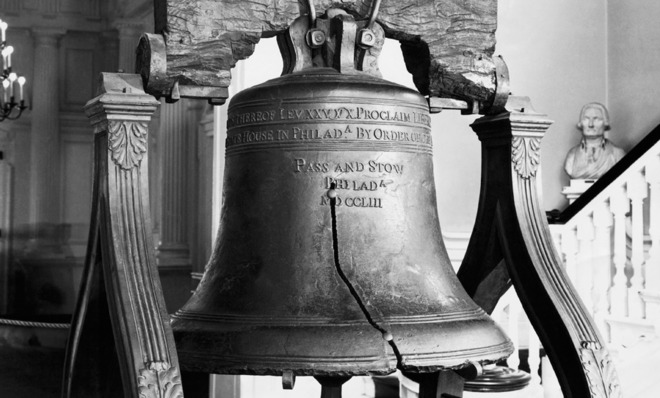How did the Liberty Bell get cracked?
An unblemished bell just wasn't meant to be


Chalk the Philly landmark's famous blemish up to faulty building materials from across the pond. In 1751, the Pennsylvania Provincial Assembly shelled out 100 pounds to London's Whitechapel Bell Foundry for a bell to hang in the State House (known post-Revolution as Independence Hall). The Whitechapel Bell Foundry — famous for casting Big Ben a century later and listed in the Guinness Book of World Records as Great Britain's oldest manufacturing company — dropped the ball on the bell, casting it with too-brittle metals.
(More from Mental Floss: 11 eat-it-all-and-it's-free road trip gems for hungry foodies)
When the bell arrived in Philadelphia in 1752, it cracked on its first test strike. Two local craftsmen, John Pass and John Stow, twice cast a new bell using metal from the cracked English bell. They also added more copper, to make the bell less brittle, and silver, to sweeten its tone. The recast behemoth weighed in at 2,000 pounds: 70 percent copper, 25 percent tin, and a scattering of lead, zinc, gold, silver, and arsenic.
The Week
Escape your echo chamber. Get the facts behind the news, plus analysis from multiple perspectives.

Sign up for The Week's Free Newsletters
From our morning news briefing to a weekly Good News Newsletter, get the best of The Week delivered directly to your inbox.
From our morning news briefing to a weekly Good News Newsletter, get the best of The Week delivered directly to your inbox.
Once Americans gained independence in 1776, the landmark fell by the wayside until the 1830s, when abolitionists adopted the bell (dubbing it "The Liberty Bell" in William Lloyd Garrison's anti-slavery publication, The Liberator) as a symbol for their movement.
There's no one widely accepted story for how the recast bell got its now-famous crack. One account asserts that the bell fractured during Revolutionary War hero Marquis de Lafayette's visit to the City of Brotherly Love in 1824. Another insists that it cracked while tolling a fire warning later that year. Craftsmen tried to prevent further damage by boring out hairline cracks on the bell, keeping them from expanding dangerously.
(More from Mental Floss: 15 brilliant life hacks to save you 15 minutes today)
Two legends about the Liberty Bell's infamous fracture remain the most popular: one contends that the bell cracked during the 1835 funeral of Chief Justice John Marshall, though it may not be historically true — Philly newspaper stories about the funeral don't mention the bell ringing.
A free daily email with the biggest news stories of the day – and the best features from TheWeek.com
The cause that stuck (at least according to official city reports) was that the Liberty Bell was irreparably damaged in 1846, when Philadelphia Mayor John Swift ordered the bell rung to commemorate George Washington's birthday. The bell had been repaired earlier that year when a thin crack started throwing off the sound of the bell, but after it cracked again, it hasn't been rung since.
The Philadelphia Public Ledger chronicled the bell's final peal in a Feb. 26, 1846, story:
"The old Independence Bell rang its last clear note on Monday last in honor of the birthday of Washington and now hangs in the great city steeple irreparably cracked and dumb. It had been cracked before but was set in order of that day by having the edges of the fracture filed so as not to vibrate against each other...It gave out clear notes and loud, and appeared to be in excellent condition until noon, when it received a sort of compound fracture in a zig-zag direction through one of its sides which put it completely out of tune and left it a mere wreck of what it was."
(More from Mental Floss: A gorgeous guide to musical notation)
-
 ‘The menu’s other highlights smack of the surreal’
‘The menu’s other highlights smack of the surreal’Instant Opinion Opinion, comment and editorials of the day
-
 Education: More Americans say college isn’t worth it
Education: More Americans say college isn’t worth itfeature College is costly and job prospects are vanishing
-
 One great cookbook: ‘More Than Cake’
One great cookbook: ‘More Than Cake’the week recommends The power of pastry brought to inspired life